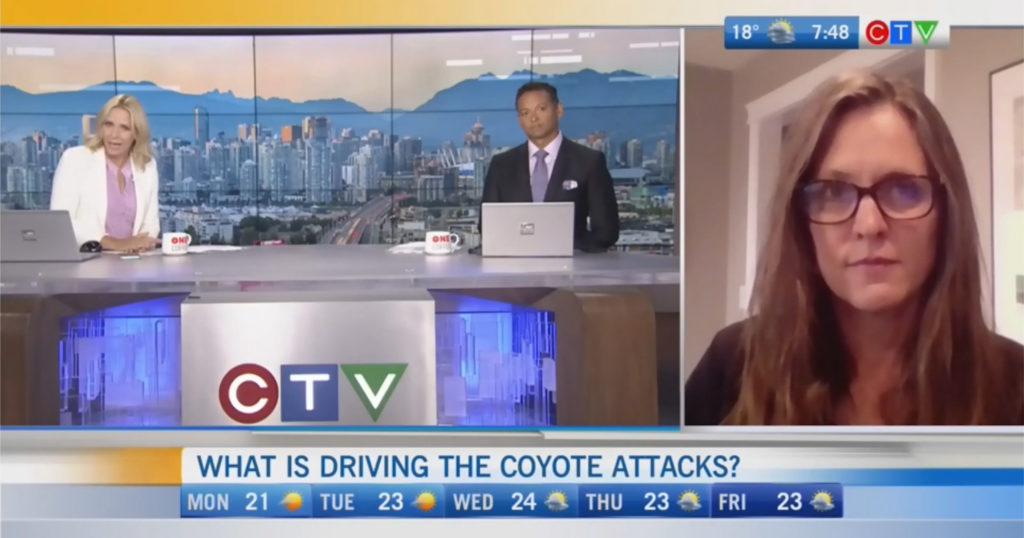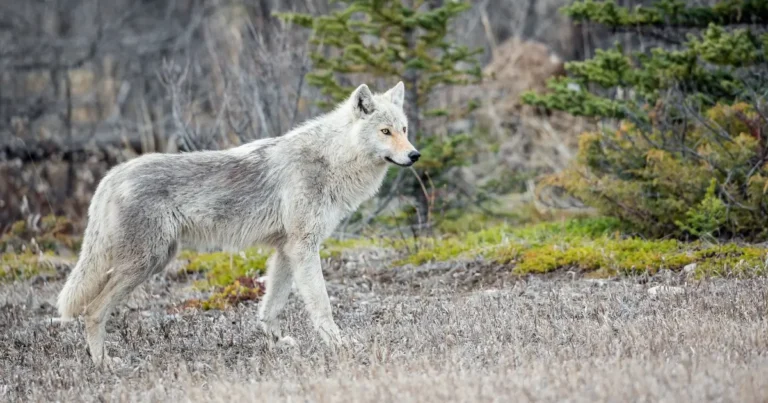
Dr. Shelley Alexander showed in a 2011 paper that Canadian media portray coyotes mostly in a negative and sensational light. She discussed how the previous can increase people’s fear of and reactivity to coyotes, obscure the scientific knowledge that can help people co-exist with coyotes, which can translate to more killing of coyotes. Then, ten years later we can see a perfect example of media sensationalizing Dr. Alexander’s own words during a live television interview.
While speaking about her evaluation of data and the six interacting factors (outlined below) most likely resulting in the negative behaviour of coyotes in Vancouver’s Stanley Park, the anchors instantaneously distilled her comments into one very controversial topic. In addition, while Dr. Alexander repeatedly stated she was discussing certain individual coyotes, the media generalized to all coyotes in the park, maligning all the individuals. Fortunately, because the interview was live, Dr. Alexander was able to correct the anchors, but those clarifications were lost in ongoing media spin off.
The exact clip transcribed below begins at the 1:34 mark of the segment, however, we have provided the entire segment in the YouTube link. Emphasis added on key information with a bold font face.
Anchor #1: “What’s driving interactions with coyotes with humans?”
Dr. Alexander: “All the attacks that do happen across Canada in the research I’ve done, 100 percent of those cases, those coyotes have been hand fed or food conditioned, so that’s a precursor to an attack. The challenge here is I’ve had a chance to look at some of the data for Stanley Park and we have a number of other things going on in Stanley Park in addition to feeding.
“There’s definitely chronic feeding by members of the public that use the parks, not just coyotes but also raccoons and other animals. This is a main precursor to conflict. There’s also… I’ve looked at some of the maps and there’s displacement of coyotes from their normal area of living by the homeless encampments. These animals have been pushed out into fringe areas where they’re more in contact with people and more likely to have conflict. The behaviour of some of these individuals suggests they’ve ingested toxins and/or drugs, possibly opioids. There’s also some indication of possible abuse of these individual animals. The enforcement is a key part of it that appears not to be followed through on for whatever the reasons are there. And then there’s non-compliance by people with the closures that have been put in place. And so these animals have been allowed to continue to engage this way in a long period of time.”
Anchor #1: “Sorry, I think this is the first time we’ve heard anyone suggest that it’s possible these animals might be under some sort of drug-induced rampage right now.”
Dr. Alexander: “Well…”
Anchor: “Go ahead.”
Dr. Alexander: “I would say… it’s extreme to say drug-induced rampage. But some of the behaviours indicating they are… it is abnormal behaviour that we’re seeing. But the key thing is here is they’ve lost their bite inhibition, so this is no longer a situation you could consider a coexistence scenario.”
Anchor #2: “But you’re pointing to the homeless encampment as a main reason why.”
Dr. Alexander: “No. I’m pointing… the homeless encampment is a contributing factor to the displacement of coyotes. As I’m saying here… there are always a constellation of events that happen that lead to these. In Stanley Park, we have a very unique situation where there’s a number of factors contributing so no one is the key cause. If any one factor is the key cause, it would be the feeding animals in Stanley Park.”
Here, Dr. Alexander was able to immediately respond to the inaccuracies of the hosts. However, often these interviews are pre-recorded and edited down for time in subsequent use; in online and print media, quotes can be edited for space. This means that not only is the full explanation sometimes missing, but there is no opportunity to correct inaccuracies. Research shows that these inaccuracies can result in real and negative effects to the carnivores they describe.
The Fur-Bearers believe that local and larger media outlets have a vital role to play in coexistence efforts and value their support. However, it is critical that journalists learn how certain words and focus can cause real world killing, and allow for contextual statements, particularly when the nuances of science are discussed.
Dr. Alexander will be appearing on a future episode of Defender Radio to discuss this experience, others and a ten-year retrospective on her paper (co-authored with Dr. Michael S. Quinn), “Portrayal of Interactions Between Humans and Coyotes (Canis latrans): Content Analysis of Canadian Print Media (1998-2010)”.
